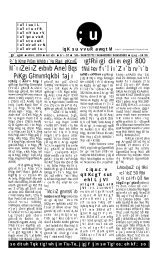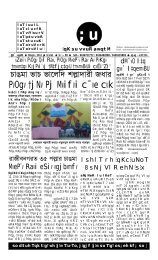You also want an ePaper? Increase the reach of your titles
YUMPU automatically turns print PDFs into web optimized ePapers that Google loves.
aJw bUP<br />
Burn, with the desire to learn!<br />
P A N K A J B U T A L I A<br />
H<br />
Sometimes, a small step can have<br />
the impact of a giant leap. A school set up<br />
by a refugee community in the North-East<br />
is one such step. Like many other tribal<br />
groups in the area, the Chakmas didn’t really<br />
have much say in their destiny post-Partition.<br />
They would have been content to be<br />
left alone, but when the line was finally drawn<br />
in 1947, the Chittagong Hill Tracts, where<br />
the Chakmas and the Hajongs lived, went to<br />
East Pakistan. As if this were not enough,<br />
the Pakistan government decided to build the<br />
Kaptai dam on the river Karnaphuli soon<br />
after. Over the next decade or so, between<br />
75,000 and 100,000 tribals from both groups<br />
were displaced from their land and, as was<br />
the norm those days, without any compensation.<br />
Wilfuly uprooting the rural poor has<br />
been a routine pastime if not sport for South<br />
Asia’s policy planners.<br />
Large numbers of the evacuees set<br />
off for India in 1964 because of Nehru’s decision<br />
to offer them shelter. About half of<br />
them settled in Mizoram and the rest were<br />
shunted around till they finally nestled in a<br />
small corner of Arunachal Pradesh. There<br />
they lived, stateless, but that at least ensured<br />
survival even though the locals wanted them<br />
out. But it’s not easy to throw out 40,000<br />
people and so they stayed, in the face of local<br />
hostility, without roads or electricity for<br />
the refugees. Ironically this spurred many of<br />
them to seek education in other parts of India.<br />
So young Chakma men went to Mumbai,<br />
Guwahati, Kolkata and Delhi. It was this<br />
exposure to the outside world which led to a<br />
desire to provide education to their own children<br />
back in Changlang district in Arunachal.<br />
In a few thatched cottages, on land<br />
loaned by a local landowner, this group of<br />
young men set up a school in 2003 with some<br />
financial assistance from the National Foundation<br />
of India, a Delhi NGO. No roads led<br />
to the school, nor did it have electricity. The<br />
initial ambition was limited — to provide<br />
basic literacy to sons and daughters of peasants<br />
who could not even imagine that education<br />
was supposed to be on their horizon.<br />
But the founders of Sneha School, as it was<br />
called, had miscalculated badly. They had no<br />
idea of the latent desire amongst the poorest<br />
of the poor for education. Within a few days,<br />
word spread and peasants trooped in from<br />
distant villages carrying children on shoulders<br />
or on dilapidated bicycles and, lo and<br />
behold, the school took off with more than<br />
150 students on its rolls.<br />
The energy this generated<br />
revolutionised the area. Within two years,<br />
the number of students had jumped to over<br />
300. The few educated Chakmas in the area<br />
all moved into teaching at the school. Their<br />
a good forty years.<br />
motivation level was high. They had not<br />
The nineties saw anti-Chakma riots imagined their deprived community would<br />
in Arunachal. One consequence of this was have such a strong desire to pull itself out<br />
the closing down of educational avenues for from the depths of misery. The school<br />
BB vIyUElt gIEsgI <strong>2011</strong> BB 22 BB









